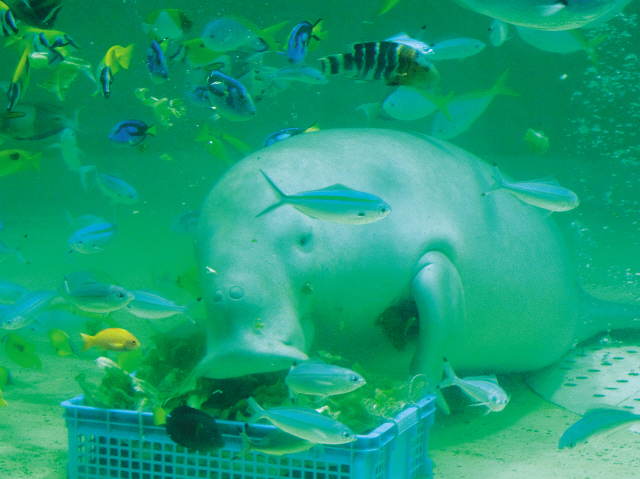TOKYO (AP) ― Americans may seem obsessed with animals, with daycare for dogs and TV therapists for cats, not to mention the hours we spend looking at photos of cute critters on the Internet. But it’s generally the conventionally adorable ones that get our attention. On a recent trip to Japan I found ample evidence of our two countries’ mutual adoration of pets and pandas. But it was a pleasure to immerse myself in a culture that shares my appreciation for more unusual creatures as well. Here are some highlights.
Dugongs
One of my lifelong dreams was to see a dugong. There are only a handful of these sea mammals related to manatees in captivity, none in North America. One of them is in the Toba Aquarium in Mie Prefecture, about three hours by train from Tokyo, http://www.aquarium.co.jp/english/index.html.
The legend of the mermaid is supposed to be a result of sailors’ sightings of dugongs. Only someone who’d been at sea and hadn’t seen a woman in an extremely long time could mistake this animal for a human beauty, with its tiny eyes, large floppy lips, and almost rectangular bald head.
 |
Serena, a dugong at the Toba Aquarium in Toba, Japan. Dugongs, a sea mammal related to the manatee, are rare in captivity. The aquarium gift shop sells stuffed dugongs and dugong cookies.(AP-Yonhap News) |
But the Japanese clearly appreciate an animal that’s so ugly that it’s cute, and Serena, at the Toba Aquarium, is the star of all the signage and publicity, as well as the model for toys and treats at the gift shop (more on that later).
I was rewarded for sharing my obsession when my Japanese friend mentioned to a staff member that I’d come all the way from America to see the dugong. A couple of hours later, she flagged us down in the hallway and gave me an impromptu behind-the-scenes tour.
Walrus shows
Most visitors don’t get to meet the dugong, but anyone at the Toba Aquarium can get up close and personal with an enormous sea mammal: Just go to the regularly scheduled walrus show.
Unlike seal and sea lion performances you may have seen at U.S. parks, these animals weren’t on a distant stage. The audience sat on benches around a floor covered with a wet tarp, with no barrier between us and the blubbery two-ton critters.
Though I couldn’t understand the trainers’ patter, the slapstick humor of the routine needed no translation. Afterward, anyone could give the performers a pat and have their picture taken.
Capybaras
I went to Toba to satisfy my dugong dream, but when I walked into the hotel I was greeted at the front desk by a photo of one of my other favorite animals: an ad proudly touting the aquarium’s recent acquisition of capybaras.
Most people in the U.S. are unfamiliar with the world’s largest rodent, but capybaras seem to be highly appreciated in Japan. There’s a cartoon character called Kapibara-san, with a small store devoted entirely to its products in Tokyo Station as well as available at other shops like the well-known Kiddyland.
And my next dream Japan vacation? It’ll be to Nagasaki Bio-Park, where there’s a large enclosure for capybaras where visitors can wander among the hundred-pound rodents and give them belly rubs.
Animal souvenirs
Years of looking for a dugong in American zoo and aquarium gift shops left me empty-handed, but at Toba, you can buy at least two dozen kinds of stuffed dugong and several varieties of dugong-themed cookies. I also bought a capybara-shaped box of crunchy strawberry chocolates.
Similar souvenirs were available at other zoos and aquariums. My travelling companion with told me that when Japanese tourists go to Loch Ness, they’re utterly bewildered by the absence of Nessie cookies.
Bugs
So-ugly-they’re-cute animals are big in Japan, but there’s also an appreciation of animals that are not cute by any definition. The Tama Zoo in Tokyo, about an hour from the city center by train, has an enormous free-flight butterfly exhibit and a large Insectarium, its entrance adorned with statues celebrating insects, including a dung beetle. But more unusual to a foreigner is the tradition of keeping insects as pets, in particular, huge beetles with frightening-looking horns.
I didn’t attend an organized beetle-wrestling tournament, but I did visit a tiny, perfectly clean shop that sells them as pets. One particularly large specimen ― if you didn’t run away screaming first ― would set you back 3,980 yen, about $50.
Dog hotels
You may think dog-owning culture is over the top in the US, but we have nothing like Wan Wan Paradise, a chain of hotels with a branch in Toba. (‘’Wan Wan’’ is the equivalent of “bow wow’’ and a kind of baby talk word for “doggie.’’)
Wan Wan Paradise is especially for people vacationing with their dogs, with a swimming pool for dogs, dog park, roof garden, and organized activities. The staff includes dog trainers and professional pet photographers. You can even bring your dog to the hotel restaurant.
A lobby bulletin board displayed photos of satisfied canine customers, and at the gift shop I bought a souvenir for my own pugs: rice crackers flavored with gourmet beef that’s a regional specialty.
Back in Tokyo at the Skytree shopping center, I ran across a cafe where you can dine with your canine, boasting a special dog menu including tiny waffles. If all this leaves travelers longing for their own pets, they can partially soothe the ache with a visit to one of Tokyo’s cat cafes, where resident pettable felines wander freely among the customers. The trend now encompasses rabbit cafes and even one with reptiles in nearby Yokohama.








